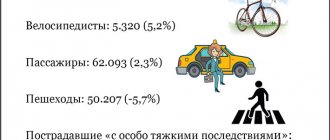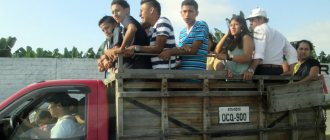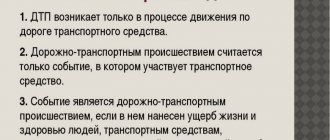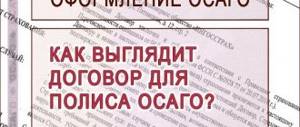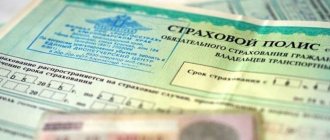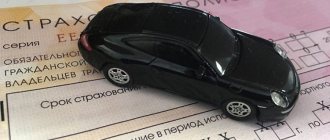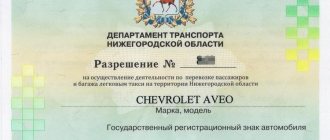Drivers' responsibilities
1. The driver of a mechanical vehicle must have with him, and at the request of police officers, hand over to them for inspection:
Driver's license
- a driver's license of the category that corresponds to the category of the vehicle. Vehicles of category A include motorcycles, and vehicles of category B include cars and trucks with a permissible maximum weight of no more than 3.5 tons, in which the number of passenger seats provided for by design is no more than eight;
- registration documents (registration certificate) for the vehicle, and if there is a trailer, also for the trailer;
- insurance policy of compulsory motor third party liability insurance (MTPL);
- in specially specified cases - other documents provided for by the Rules.
Fasten your seat belt
2. When driving a vehicle, be wearing a seat belt and ensure that passengers, including those riding in the rear seats of a car, also wear their seat belts.
When driving a motorcycle, wear a fastened motorcycle helmet and do not carry passengers without a fastened motorcycle helmet.
3. Before leaving, check and ensure that your vehicle is in good technical condition on the way.
4. At the request of police officers, undergo an examination for intoxication, which can be carried out at the place of the stop or in a drug laboratory.
5. Provide your vehicle in cases provided for by law:
- police officers;
- employees of federal state security agencies;
- FSB employees;
- medical and pharmaceutical workers to transport citizens to the nearest medical facility in cases that threaten their lives.
The right to stop a vehicle is granted to traffic controllers. Persons who have the right to stop a vehicle are required to present a service ID or license plate upon the driver’s request.
Responsibilities of pedestrians and passengers
7. Pedestrians must move on the sidewalk, footpath, or pedestrian and bicycle path, or on a shared pedestrian and bicycle path, or, if there is none, on the side of the road. If there is no sidewalk, pedestrian path, pedestrian and bicycle path, common pedestrian and bicycle path or shoulder, or if movement along them is impossible, pedestrians are allowed to move along the edge of the roadway in one row (on roads with a dividing strip - along the outer edge) .
8. Move on a sidewalk, pedestrian path, pedestrian and bicycle path, shared pedestrian and bicycle path or shoulder using roller skates, skateboards, etc. equipment intended for sports and recreation is permitted provided that it does not interfere with other pedestrians. It is permitted to cross the roadway on the said road at a speed not exceeding the speed of pedestrians.
9. Pedestrians, when moving along the edge of the roadway or shoulder, must walk towards the movement of vehicles. Those who use wheelchairs or push a motorcycle, moped, bicycle, etc. along the edge of the roadway or shoulder, it is allowed to move on any side of the road.
10. At night, if the road is insufficiently and unevenly lit, pedestrians on the roadway or side of the road should wear a reflective vest or clothing with clearly visible elements of reflective material.
[Remember! The presence of reflective elements on your clothing and accessories allows drivers to notice you in a timely manner]
11. The movement of organized groups of people on the road is permitted only on the right side of the roadway in the direction of movement of vehicles in a column of no more than four people in a row. In front and behind the column on the left side there should be accompanying persons with red flags, and in the dark and in case of insufficient visibility - with lit lanterns: in front - white, in back - red.
12. Groups of children are allowed to move only during daylight hours on sidewalks, pedestrian paths or along pedestrian and bicycle paths or common pedestrian and bicycle paths, and in their absence, also on the right side of the road in the direction of movement of vehicles in a column of no more than two children per group. row. There must be adult escorts with red flags in front and behind the column on the left side.
13. Pedestrians must cross the roadway at pedestrian crossings (underground or overground), and if there are none, at intersections along an imaginary extension of the sidewalk or curb. If there is no pedestrian crossing or intersection in the visibility zone, it is allowed to cross the roadway at right angles to the edge of the roadway in places where the road is clearly visible in both directions.
14. In places where road traffic is regulated, pedestrians must be guided by the signals of the traffic controller or pedestrian traffic light, and in their absence, by the signals of the traffic light regulating the movement of vehicles (hereinafter referred to as the traffic light).
15. Before crossing the roadway at a pedestrian crossing in places where traffic is not regulated, pedestrians need to assess the distance to approaching vehicles, their speed, and also make sure that it is safe to cross the roadway.
16. Pedestrians are allowed to enter the roadway outside a pedestrian crossing in places where traffic is not regulated only after they have assessed the distance to approaching vehicles, the speed of their movement, are convinced of the safety of crossing the roadway and will not interfere with the movement of vehicles.
17. Pedestrians should not linger or stop on the roadway unnecessarily. Pedestrians who do not have time to complete the crossing of the roadway, if possible, should stop at the “Safety Island”. Pedestrians may continue crossing the roadway only after making sure that further movement is safe.
18. Pedestrians are prohibited from:
18.1. cross the roadway outside a pedestrian crossing if there is a dividing strip on the road, as well as in places where pedestrian or road barriers are installed, with the exception of places where the fences have passages provided for crossing the roadway;
18.2. cross the roadway outside a pedestrian crossing on roads where traffic flows in both directions and has four or more lanes;
18.3. driving on a road marked with a road sign
552 ;
18.4. go out onto the previous part because of a standing vehicle or other obstacle that limits visibility, without making sure that there are no approaching vehicles.
19. When an operational vehicle approaches with a blue or blue and red flashing light turned on and a special sound signal turned on, pedestrians are prohibited from entering the roadway, and pedestrians on the roadway must give way to the mentioned vehicles.
20. Waiting for public passenger vehicles is allowed only on landing areas, and if there are none, on the sidewalk or roadside.
21. At stops of a public passenger vehicle that do not have landing areas, it is permitted to enter the roadway to board the public passenger vehicle only after it has come to a complete stop. After disembarking from the tram, pedestrians must clear the roadway.
22. Boarding and disembarking passengers is permitted only after the vehicle has come to a complete stop. This is done from the sidewalk, landing area or curb. If boarding or alighting from a trackless vehicle is not possible from the side of the sidewalk, landing area or shoulder, boarding or alighting is permitted from the side of the roadway, provided that it is safe and does not interfere with the movement of other vehicles.
23. Passengers sitting in seats equipped with seat belts must wear their seat belts while driving. Passengers of motorcycles, tricycles, ATVs and mopeds are required to wear a fastened motorcycle helmet while driving (except if the vehicle has a closed body).
24. Passengers are prohibited from:
24.1. interfere with the driver or distract his attention while driving;
24.2. open the vehicle door if this threatens road safety or interferes with other road users;
24.3. leave the seat without an invitation if the vehicle is stopped at the request of an official of the competent authorities.
The driver is prohibited
Driving a vehicle while intoxicated
- drive a vehicle in a state of alcohol, drugs or other intoxication, under the influence of medications that impair attention and slow reaction, in a painful or tired state that jeopardizes traffic safety;
- transfer control to persons in such a state;
- use intoxicating substances between the commission of an accident and the passage of an examination for intoxication, or between a stop for the purpose of conducting an examination and its implementation;
- transfer control to persons who do not have a driver’s license or are not included in the MTPL insurance policy;
- cross organized transport and foot columns and take place in them;
- drive a vehicle in violation of the work and rest schedule;
- use while driving a telephone that is not equipped with a “hand-free” technical device that allows you to negotiate without using your hands.
Driver's actions in case of an accident
In case of a traffic accident with injured or killed, the driver involved in it is obliged to:
Put up a warning triangle
- Stop immediately, turn on your hazard lights and display a warning triangle. Do not move objects related to the incident.
- Call an ambulance or rescuers (from a mobile phone - call 112). Before their arrival, provide first aid to the victims. In exceptional cases, it is allowed to send the victims to the nearest medical facility in a passing vehicle or in their own vehicle. In the latter case, after delivering the victim to the hospital, the participant in the accident is obliged to return to the scene of the accident.
- Report the incident to the police (from a mobile phone - call 112). Write down the names and addresses of eyewitnesses and wait for the police to arrive. The roadway can only be cleared upon command from the police. However, if the movement of other vehicles is impossible, then the driver must record in the presence of witnesses all traces and objects related to the incident and organize a detour around them. After this, you can clear the roadway.
- Notify your insurance company about the accident. After registering an accident, police officers, together with other participants in the incident, fill out a Notice of Road Accident. Subsequently, the completed notice is submitted to the insurance company along with documents prepared by the police:
- a copy of the accident certificate;
- a copy of the protocol on the administrative offense;
- a copy of the resolution in the case of an administrative offense.
Road accident without injuries
Road accident without injuries
In case of an accident without injuries, steps 1, 3 and 4 must be followed. Before the police arrive, you should carefully inspect the scene of the accident and the damage to your vehicle.
The information you collect can be very useful when filing an accident.
If there are no victims in an accident and there are no disagreements between its participants, then instead of calling the traffic police, it is allowed to independently come to the nearest traffic police post or police department with a road accident diagram drawn up and signed by both participants.
Since the road accident diagram is evidence in a traffic accident case, you can sign it only after making sure that everything depicted on the diagram corresponds to reality.
If only two vehicles are involved in an accident without casualties, the owners of which have valid MTPL policies, and there are no disagreements about the circumstances of the incident and the nature of the damage caused, it is permissible not to involve police officers in registering the incident, but to confine oneself to filling out an Accident Notice so that the insurance company compensates the victim harm caused.
At the same time, the victim must keep in mind that with a simplified registration procedure, the maximum possible amount of compensation is 25 thousand rubles. If the preliminary assessment of the damage caused exceeds this amount, it is necessary to register an accident with the involvement of traffic police officers.
Passenger Responsibilities
1. Passengers are obliged to:
- when traveling in a vehicle, wear seat belts, and when riding a motorcycle, wear a fastened motorcycle helmet;
- boarding and disembarking from the car should be done from the sidewalk or curb and only after a complete stop. Boarding and disembarking from the side of the roadway is permitted provided that it is safe for the passenger and does not interfere with other road users.
2. Passengers are prohibited from:
- distract the driver while driving;
- when traveling on a truck with a flatbed, stand, sit on the sides or on a load above the sides;
- open the doors of the vehicle while it is moving.
What is the responsibility of each participant in the DD?
All information about this issue is specified in the traffic rules. Just open the document and study the data presented. In a short version, it looks like this:
| The pedestrian is obliged | The passenger is obliged |
Information is presented in Chapter 4 of the Traffic Regulations. The most important points:
| The information is presented in Chapter 5 of the Traffic Regulations and reads like this:
|
The listed rules must be observed unquestioningly, since any violation of them leads to an accident. For non-compliance, the driver is given a serious fine.
Responsibilities of pedestrians
- Pedestrians must walk on sidewalks, verges or footpaths. In the absence of sidewalks, pedestrian paths and roadsides, pedestrians can move in one row along the edge of the roadway towards the movement of vehicles.
- Pedestrians must cross the roadway at pedestrian crossings, and if there are none, at intersections along a line that continues the line of the sidewalk or curb. At unregulated pedestrian crossings and intersections, pedestrians can enter the roadway only after assessing the distance to approaching vehicles and their speed, and making sure that crossing the road will be safe for them. If there is no crossing or intersection in the visibility zone, it is allowed to cross the road strictly across the roadway, provided that the road section does not have a dividing strip or fences and is clearly visible in both directions.
- In places where traffic is regulated, pedestrians must follow the signals of the traffic light or traffic controller.
- If a vehicle with special signals (blue flashing light and siren) is approaching the place where a pedestrian is crossing the road, then the pedestrian must refrain from crossing. A pedestrian who is already on the roadway at this moment must immediately clear it without interfering with a special vehicle.
- Waiting for a tram, trolleybus, bus, minibus and regular taxi is allowed only on landing platforms, and in their absence - on the sidewalk or on the side of the road. It is permitted to enter the roadway to board a vehicle only after it has stopped (this requirement also applies to boarding a tram that has stopped in the middle of the roadway).
Traffic rules for pedestrians
In driving schools, when considering situations involving pedestrians, drivers are directed to ensure that the latter are right.
This is a preventive measure and a good warning. According to the rules, a pedestrian does not have priority over vehicles. Traffic regulations give a clear interpretation of the term “pedestrian”. This is a person who is outside of transport and not working on the roadway. A pedestrian includes a person moving in a wheelchair, driving a bicycle, motorcycle, pulling a sled, cart, baby stroller or wheelchair.”
The definition clearly delineates entities that may have a dual role. The rules are clear:
- if you ride a bicycle, you obey the rules for the driver;
- If you drive a bicycle, you obey the rules for a pedestrian.
Major traffic violations by pedestrians
1. Violation of markings and signs
Everyone must know the definition of a pedestrian crossing. It is defined as a part of the road that is marked with signs and (or) markings and is designated for the movement of pedestrians. If there is no marking, the width of the transitions is set by the distance between the signs.
Depending on the situation, the transition is indicated differently:
- markings and signs;
- one marking;
- just signs.
2. Ignorance of the rules
The “Give Way” requirement means that a pedestrian cannot start, resume, continue moving, or perform maneuvers if these actions interfere with other road users who have priority over him. Most people do not know this requirement and the fact that traffic police officers in each specific situation may interpret it differently.
It must be remembered that the driver, pedestrian, passenger are equal participants in the movement. They have their own rights, duties and responsibilities.
Responsibilities of pedestrians traffic rules
The responsibilities of a pedestrian of the traffic rules are stated in chapter 4 and paragraphs of rules 4.3;
4.5 and 17.1. Chapter 4 of the Traffic Regulations for Pedestrians explains their responsibilities . It is necessary to know the points at which vehicular traffic intersects with pedestrian traffic and a question of dominance may arise.
Clause 4.3. defines the rules of a pedestrian, where he is obliged to move across the road :
- along a pedestrian crossing (underground and overground);
- if there are no crossings, then at intersections;
- if there is no crossing or intersection, then it is possible to cross the road perpendicular to the roadway.
It is worth remembering that crossing a road other than a crossing is an exception. You need to cross the road only at the pedestrian crossing.
Clause 4.5 determines the correct movement along an unregulated crossing . You can go out on the road only after assessing the distance to moving cars. You need to roughly estimate their speed and make sure that you can cross safely.
It must be remembered that when moving outside pedestrian crossings, a person should not interfere with transport. It is prohibited to get out from behind a stationary vehicle or other obstacle unless you are sure that there are no moving cars.
There are two important points to remember:
- own safety is the responsibility of the pedestrian;
- When moving outside the crossing, a pedestrian has no advantage over vehicles.
Clause 17.1 determines the movement of pedestrians in the residential area and courtyard areas . Pedestrians are allowed to move on sidewalks and roadways if they do not create unreasonable interference with traffic. In a residential area, pedestrians have advantages over vehicles
Responsibility for violation of traffic rules by pedestrians
According to the law, a pedestrian is responsible for violating traffic rules.
The liability of pedestrians is regulated by sections 4 and 5 of the Russian Traffic Regulations. Administrative responsibility of a pedestrian:
- traffic violations are subject to a fine of 500 rubles;
- violations that result in interference with the movement of vehicles are punishable by a fine of 1,000 rubles;
- Violations resulting in mild or moderate harm to the health of the victim are punishable by a fine of 1,000 to 1,500 rubles.
Criminal liability of a pedestrian:
- If the violations lead to serious harm to health, the perpetrator may be subject to criminal liability for up to 3 years.
- If the violations lead to the death of the victim, the perpetrator may be subject to criminal liability for up to 4 years.
- If violations result in the death of two or more people, the perpetrator may be subject to criminal liability for up to 7 years.
Also, after assessing the damage, liability regulated by the Civil Code may arise:
The pedestrian is liable for damage to property, health, and moral harm, including to the owners of cars, motorcycles and other vehicles.
Video: Responsibilities of a pedestrian Traffic Regulations of the Russian Federation

